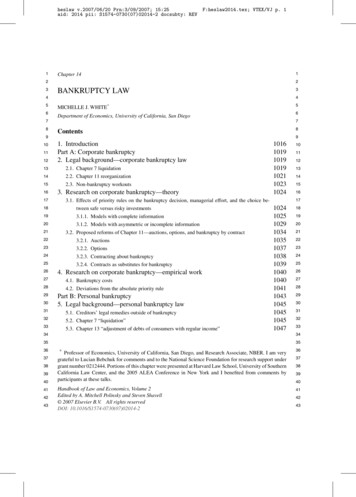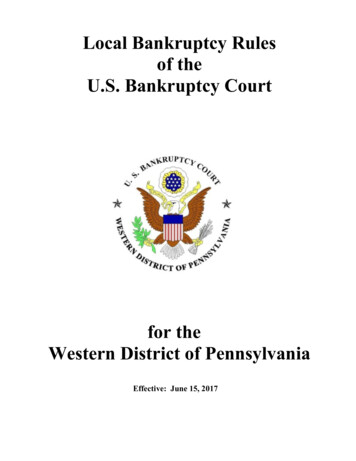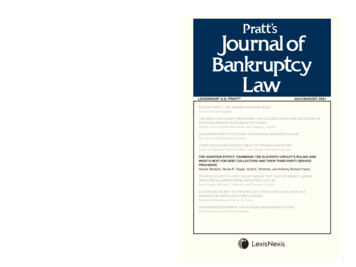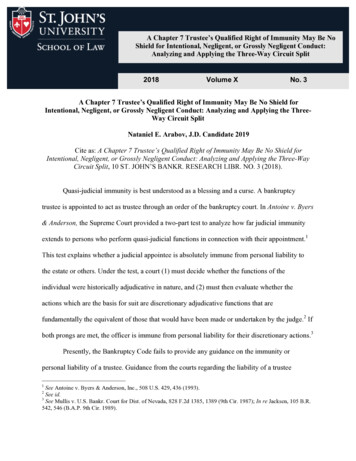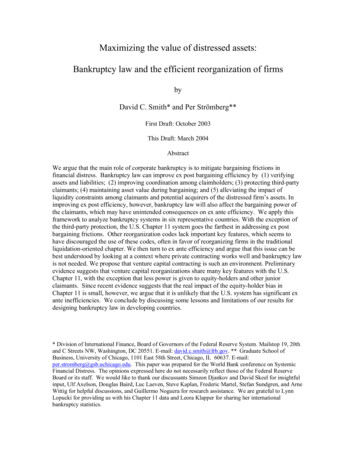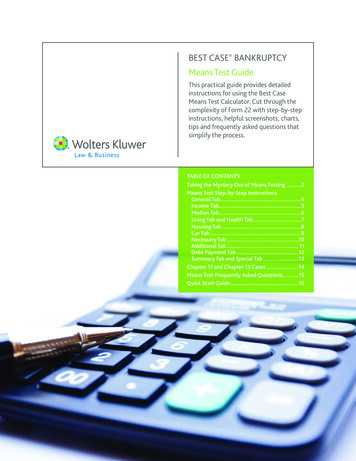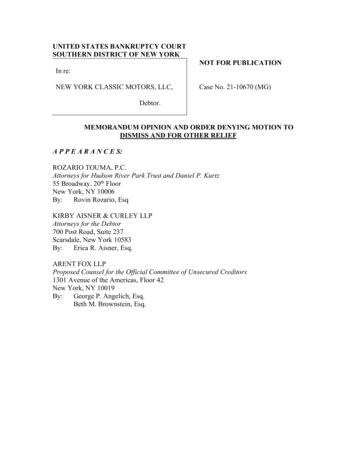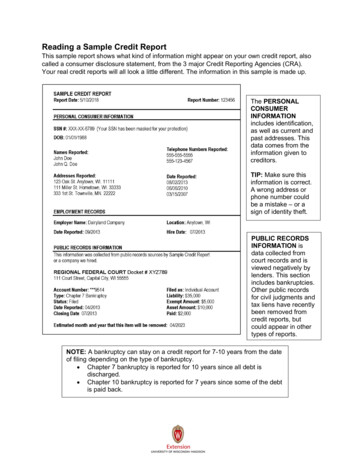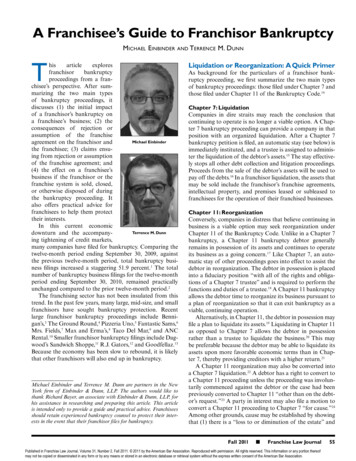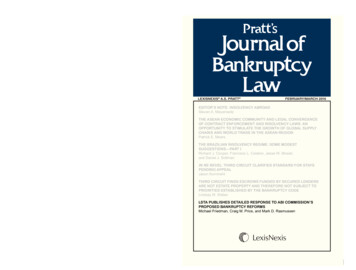
Transcription
PC / Ivory Vellum Carnival 35x23 / 80PRATT’S JOURNAL OF BANKRUPTCY LAWLEXISNEXIS A.S. PRATT FEBRUARY/MARCH 2016EDITOR’S NOTE: INSOLVENCY ABROADSteven A. MeyerowitzVOLUME 12 NUMBER 2THE ASEAN ECONOMIC COMMUNITY AND LEGAL CONVERGENCEOF CONTRACT ENFORCEMENT AND INSOLVENCY LAWS: ANOPPORTUNITY TO STIMULATE THE GROWTH OF GLOBAL SUPPLYCHAINS AND WORLD TRADE IN THE ASEAN REGIONPatrick E. MearsTHE BRAZILIAN INSOLVENCY REGIME: SOME MODESTSUGGESTIONS—PART IRichard J. Cooper, Francisco L. Cestero, Jesse W. Mosier,and Daniel J. SoltmanIN RE REVEL: THIRD CIRCUIT CLARIFIES STANDARD FOR STAYSPENDING APPEALJason KornmehlTHIRD CIRCUIT FINDS ESCROWS FUNDED BY SECURED LENDERSARE NOT ESTATE PROPERTY AND THEREFORE NOT SUBJECT TOPRIORITIES ESTABLISHED BY THE BANKRUPTCY CODELindsay M. WeberFEBRUARY/MARCH 2016LSTA PUBLISHES DETAILED RESPONSE TO ABI COMMISSION’SPROPOSED BANKRUPTCY REFORMSMichael Friedman, Craig M. Price, and Mark D. Rasmussen
QUESTIONS ABOUT THIS PUBLICATION?For questions about the Editorial Content appearing in these volumes or reprint permission,please call:Kent K. B. Hanson, J.D. at . 415-908-3207Email: . kent.hanson@lexisnexis.comFor assistance with replacement pages, shipments, billing or other customer service matters,please call:Customer Services Department at . . . . . . . . . . . . . . . . . . . . . . . . . . . (800) 833-9844Outside the United States and Canada, please call . . . . . . . . . . . . . . . . (518) 487-3000Fax Number . . . . . . . . . . . . . . . . . . . . . . . . . . . . . . . . . . . . . . . . (518) 487-3584Customer Service Web site . . . . . . . . . . . . . . . . . . . http://www.lexisnexis.com/custserv/For information on other Matthew Bender publications, please callYour account manager or . . . . . . . . . . . . . . . . . . . . . . . . . . . . . . . . (800) 223-1940Outside the United States and Canada, please call . . . . . . . . . . . . . . . . . (518) 487-3000Library of Congress Card Number: 80-68780ISBN: 978-0-7698-7846-1 (print)ISBN: 978-0-7698-7988-8 (eBook)ISSN: 1931-6992Cite this publication as:[author name], [article title], [vol. no.] PRATT’S JOURNAL OF BANKRUPTCY LAW [page number]([year])Example: Patrick E. Mears, The Winds of Change Intensify over Europe: Recent European UnionActions Firmly Embrace the “Rescue and Recovery” Culture for Business Recovery, 10 PRATT’S JOURNALOF BANKRUPTCY LAW 349 (2014)This publication is sold with the understanding that the publisher is not engaged in rendering legal,accounting, or other professional services. If legal advice or other expert assistance is required, the services ofa competent professional should be sought.LexisNexis and the Knowledge Burst logo are registered trademarks of Reed Elsevier Properties Inc., usedunder license. A.S. Pratt is a registered trademark of Reed Elsevier Properties SA, used under license.Copyright 2016 Reed Elsevier Properties SA, used under license by Matthew Bender & Company, Inc.All Rights Reserved.No copyright is claimed by LexisNexis, Matthew Bender & Company, Inc., or Reed Elsevier Properties SA,in the text of statutes, regulations, and excerpts from court opinions quoted within this work. Permission tocopy material may be licensed for a fee from the Copyright Clearance Center, 222 Rosewood Drive, Danvers,Mass. 01923, telephone (978) 750-8400.An A.S. Pratt PublicationEditorial Office630 Central Ave., New Providence, NJ 07974 (908) 464-6800www.lexisnexis.com(2016-Pub.4789)
Editor-in-Chief, Editor & Board ofEditorsEDITOR-IN-CHIEFSTEVEN A. MEYEROWITZPresident, Meyerowitz Communications Inc.EDITORVICTORIA PRUSSEN SPEARSSenior Vice President, Meyerowitz Communications Inc.BOARD OF EDITORSScott L. BaenaBilzin Sumberg BaenaPrice & Axelrod LLPThomas W. CoffeyTucker Ellis & West LLPRobin E. KellerLovellsLeslie A. BerkoffMoritt Hock & HamroffLLPMichael L. CookMatthew W. LevinSchulte Roth & Zabel LLP Alston & Bird LLPTed A. BerkowitzFarrell Fritz, P.C.Mark G. DouglasJones DayPatrick E. MearsBarnes & Thornburg LLPAndrew P. BrozmanClifford Chance US LLPTimothy P. DugganStark & StarkAlec P. OstrowStevens & Lee P.C.Kevin H. BuraksPortnoff Law Associates,Ltd.Gregg M. FicksCoblentz, Patch, Duffy &Bass LLPDeryck A. PalmerPillsbury Winthrop ShawPittman LLPPeter S. Clark IIReed Smith LLPMark J. FriedmanDLA PiperN. Theodore Zink, Jr.Chadbourne & Parke LLPPRATT’S JOURNAL OF BANKRUPTCY LAW is published eight times a year by MatthewBender & Company, Inc. Copyright 2016 Reed Elsevier Properties SA., used under license byMatthew Bender & Company, Inc. All rights reserved. No part of this journal may be reproducedin any form—by microfilm, xerography, or otherwise—or incorporated into any informationretrieval system without the written permission of the copyright owner. For permission tophotocopy or use material electronically from Pratt’s Journal of Bankruptcy Law, please accesswww.copyright.com or contact the Copyright Clearance Center, Inc. (CCC), 222 RosewoodDrive, Danvers, MA 01923, 978-750-8400. CCC is a not-for-profit organization that provideslicenses and registration for a variety of users. For subscription information and customer service,call 1-800-833-9844.Direct any editorial inquires and send any material for publication to Steven A. Meyerowitz,iii
Editor-in-Chief, Meyerowitz Communications Inc., 26910 Grand Central Parkway, No. 18R,Floral Park, NY 11005, smeyerowitz@meyerowitzcommunications.com, 718.224.2258. Materialfor publication is welcomed—articles, decisions, or other items of interest to bankers, officers offinancial institutions, and their attorneys. This publication is designed to be accurate andauthoritative, but neither the publisher nor the authors are rendering legal, accounting, or otherprofessional services in this publication. If legal or other expert advice is desired, retain theservices of an appropriate professional. The articles and columns reflect only the presentconsiderations and views of the authors and do not necessarily reflect those of the firms ororganizations with which they are affiliated, any of the former or present clients of the authorsor their firms or organizations, or the editors or publisher. POSTMASTER: Send address changesto Pratt’s Journal of Bankruptcy Law, LexisNexis Matthew Bender, 630 Central Avenue, NewProvidence, NJ 07974.iv
LSTA’S RESPONSE TO ABI COMMISSION’S PROPOSED CHAPTER 11 REFORMSLSTA Publishes Detailed Response to ABICommission’s Proposed Bankruptcy ReformsBy Michael Friedman, Craig M. Price, and Mark D. Rasmussen*This article summarizes a few of the most significant points offered up bythe Loan Syndications and Trading Association against the Commission ofthe American Bankruptcy Institute to Study the Reform of Chapter 11proposed reforms.The Commission of the American Bankruptcy Institute to Study the Reformof Chapter 11 (the “Commission”) recently published its report (the “ABIReport”), which contained over 200 distinct proposed amendments to theBankruptcy Code. The Loan Syndications and Trading Association (“LSTA”)1released its own response to the ABI Report, titled “The Trouble withUnneeded Bankruptcy Reform: The LSTA’s Response to the ABI Chapter 11Commission Report” (the “Response”).2 After a comprehensive review of theCommission’s proposals, the LSTA believes that the ABI Report’s overallapproach to reforming the Bankruptcy Code is misguided and that, if therecommendations contained in the ABI Report were adopted, the changeswould be overwhelmingly harmful to debtors, creditors and credit markets,increasing the cost of credit to both performing and distressed businesses alike.This article summarizes a few of the most significant points offered up by theLSTA against the Commission’s proposed reforms.THE LSTA ARGUES THAT THE ABI REPORT’S PROPOSALSWOULD OVERWHELMINGLY DAMAGE THE RIGHTS OFSECURED CREDITORS AND ARE WHOLLY UNNECESSARYThe ABI Report makes a number of recommendations that would weaken*Michael Friedman is a partner in Chapman and Cutler LLP’s Banking and FinancialServices Department and Co-Practice Group Leader of the firm’s Bankruptcy and RestructuringGroup. Craig M. Price is a partner in the firm’s Bankruptcy and Restructuring Group. Mark D.Rasmussen is a partner in the Bankruptcy and Restructuring and Litigation Groups. The hapman.com,andmark.rasmussen@chapman.com, respectively.1The LSTA is a leading trade organization representing banks, insurance companies, fundmanagers, and other institutional investors that originate, syndicate, and invest in securedcorporate loans and that trade in the secondary market for performing, stressed, and distressedloans and claims.2The Response was drafted by LSTA’s counsel at WilmerHale and included input andcomments from a working group which included lawyers from Chapman and Cutler LLP.107
PRATT ’S JOURNALOFBANKRUPTCY LAWsecured creditors’ existing protections under the Bankruptcy Code. Among themost potentially damaging proposals are: (i) diluting secured creditors’ ability toobtain adequate protection against the depreciation of their collateral duringthe Chapter 11 process by introducing and limiting such protections to the“foreclosure value” of such collateral; (ii) requiring senior secured creditors todistribute a redemption option premium to out-of-the-money junior creditorsto achieve a “fairer” distribution of assets in violation of the absolute priorityscheme; and (iii) imposing stringent limitations on the terms of debtor-inpossession (“DIP”) financing and on sales of a debtor’s assets under § 363 of theBankruptcy Code.The LSTA’s Response examines what it sees as the numerous flaws in theCommission’s overall approach to bankruptcy reform, and largely focuses onthe lack of empirical evidence showing that reform is necessary, the potentialcosts of the Commission’s proposals to the efficiency of the bankruptcy processand to the broader credit markets and the harm it believes could be created ifthe Commission’s reforms are adopted. We agree with these assessments. Setforth below is a summary of the LSTA’s arguments.THE COMMISSION’S PREMISE FOR REFORM IS MISGUIDEDThe Response begins by examining the Commission’s underlying premisesfor reform—that the “balance” between the “rights of senior creditors” asagainst “the reorganization needs of the debtor and the interests of otherstakeholders” is now askew, that increased secured creditor control hasundermined the effectiveness of the Bankruptcy Code and reforms are necessaryto make the bankruptcy process more “fair.” The Commission’s solution tothese perceived problems is to reduce secured creditor control by placing morepower in the hands of the debtor.3 The Response points out, however, that theCommission offers no reliable empirical evidence to support its underlyingneed for reform. Rather, the Commission, by its own admission, relies only on“anecdote” and “perception,” and the ABI Report fails to provide any reliableempirical evidence that, in the real world, debtors are making inefficientdecisions that systematically favor secured creditors over other constituencies.4To the contrary, the Response cites recent studies that have investigatedprecisely this concern and suggest that the increased use of secured credit—andthe power that secured creditors potentially wield in bankruptcy—has notproduced a greater number of inefficient sales or liquidations. On the contrary,3Response at 18.4Id. at 13.108
LSTA’S RESPONSE TO ABI COMMISSION’S PROPOSED CHAPTER 11 REFORMSthese studies reveal that secured creditor control does not lead to value reducingliquidations of otherwise viable businesses.5 Instead of secured creditor controldamaging the bankruptcy process, such studies found that “the conventionalpicture of secured creditor control and [§]363 sales is misleading andoverstated.”6 Rather than secured creditors forcing quick sales, the evidencecited in the Response suggests that in cases with a dominant secured party ora high percentage of secured debt, a § 363 sale was less likely, rather than morelikely, to occur.7 Moreover, the studies cited found that secured creditor controldoes not lead to lower unsecured creditor recoveries.8Given the lack of supporting evidence contained in the ABI Report, studiesexamining the proposed reforms have found that “[i]n the absence of reliabledata demonstrating that a problem actually exists, we should hesitate beforetrying to fix the ‘problem.’ ”9 The Response asserts that empirical evidencesimply does not support the claims that secured creditors have too muchcontrol over the Chapter 11 process or that such perceived secured creditorcontrol has damaged the Chapter 11 process. In the absence of such evidence,the Response argues that there is no justification for the drastic changesproposed in the ABI Report.BECAUSE IT’S NOT BROKE—DON’T FIX ITIn the ABI Report, the Commission argues that in the past, cases were longer,resulting in fairer treatment of all the parties and a more likely chance ofreorganization. Today, the Commission claims that secured creditors are tooquick to force a § 363 sale that possibly destroys value. Contrary to theseclaims, the Response argues that reform is not necessary as Chapter 11 “as is”is incredibly successful and works with remarkable efficiency. While the averagestay in Chapter 11 for public and large private companies has plummeted, theResponse argues that the speed of these cases is not a negative, but rather, resultsin greater recoveries for all creditors. Cases are also quicker, the Responseargues, because since the advent of the Bankruptcy Code, the variousconstituent parties of today are more sophisticated and markets have become5Id.; see e.g., Jay Lawrence Westbrook, Secured Creditor Control and Bankruptcy Sales: AnEmpirical View, 2015 U. Ill. L. Rev. 831, 831 (“Westbrook”).6Prof. Westbrook also found that secured creditor control, although important, is “not aspervasive as many have assumed” and that the “data strongly suggest that the conventional viewthat 363 sales dominate Chapter 11 practice is simply wrong.” Westbrook, Id. at 834, 843.7Response at 21.8Id.9Id. at 13, citing Westbrook at 845.109
PRATT ’S JOURNALOFBANKRUPTCY LAWmore liquid, making it easier for parties to trade in and out of debt.Nonetheless, given these changes, the research cited by the Response confirmsthat all parties still retain significant bargaining power.10The Response argues that while financial markets and Chapter 11 practicehave indeed changed significantly, there is no reliable evidence that thosechanges have been harmful. Rather, over time the Chapter 11 process hasbecome faster, more efficient, and in many ways better than it was in the past.As proof of this success, other nations have sought to model their owninsolvency laws on Chapter 11. Specifically, the Response points out that Brazil,the Czech Republic, and China have each recently adopted bankruptcy lawsmodeled on Chapter 11, including effective protections for secured creditorsnon-bankruptcy rights.11 All of these factors, the Response claims, point to thefact that major reforms are not necessary.THE REFORMS WOULD MAKE THE BANKRUPTCY PROCESSMORE EXPENSIVE AND TIME CONSUMING, NEGATIVELYEFFECT CREDIT MARKETS AND FAIL TO MAKE THEBANKRUPTCY PROCESS MORE “FAIR”The Response also challenges the Commission’s assertion that its proposalsare designed to reduce the cost of bankruptcy, arguing instead that such reformswould make many cases longer, more complicated and costlier. In particular,the Response points out that reforms such as the proposed 60-day moratoriumon § 363 sales,12 as well as the proposal requiring several different types ofjudicial valuations—each requiring costly document discovery, accounting, andoutside expert analysis—would add substantial time and expense to thebankruptcy process. The proposed reforms would also complicate the process.For example, the “redemption option value” proposal would require bankruptcycourts to determine the value of a hypothetical option to purchase the firm,which entails ascertaining the expected volatility in the firm’s value over theredemption period. At best, any such inquiry would be extremely difficult toascertain.The Response also points out that because the proposed reforms wouldreduce secured creditors’ recoveries, they would inevitably make it harder and10Id. at 63.11Id. at 24–26.12The 60-day moratorium is specifically designed to extend the length of bankruptcy in thehope that more companies will be reorganized and that secured creditors will be less able to forcevalue-reducing sales. Id. at 27.110
LSTA’S RESPONSE TO ABI COMMISSION’S PROPOSED CHAPTER 11 REFORMSmore expensive for all companies to access credit.13 In making this argument,the Response cites to a report from Fitch which noted the Commission’schanges will decrease lenders’ recoveries, and that lenders charge more interestto borrowers expected to have a lower “recovery given default.”14 Similarly,witnesses testified before the Commission that the proposed reforms wouldincrease the price of secured credit.15 That secured credit would become moredifficult and costly to obtain in such circumstances is not just a supposition.Rather, when the United Kingdom instituted a similar reform with TheEnterprise Act of 2002, creating a carve-out, known as the “prescribed part”that diminished the value of floating charges in order to pay a portion of theclaims of general unsecured creditors, credit became more expensive and moredifficult to obtain.16 Similarly, legislation in Sweden which reduced the rightsof secured creditors by enabling floating charges to secure only 55 percent of thevalue of collateral was found to raise interest rates and reduce the availability ofcredit, and was ultimately abolished.17Lastly, the LSTA points out that the Commission seeks to replace fundamental principles of bankruptcy law with its own view of “subjective fairness.”18However, according to the LSTA, the Bankruptcy Code does not have asubstantive vision of a “fair” distribution of value; rather, it allocates value inaccordance with the parties’ non-bankruptcy state law property rights, entitlements and priorities. The LSTA alleges that abandoning the core principles thathave formed the backbone of Chapter 11—such as absolute priority andadequate protection—would contravene state law, be unfair to those that havecome to rely on such laws and only serve to make the law uncertain when itshould be clear and predictable.19 We would agree. Altering those fundamental13Id. at 28–30.14Id. at 28 (citing FitchRatings, Fitch: Proposed Changes to Chapter 11 Could Pressure FirstLien Recoveries if Adopted (Dec. 9, 2014), available at elease?id 946215).15Market participants testified before the Commission that reducing secured creditorrecoveries would almost certainly increase the cost of leveraged loans by lowering expectedrecoveries, or making it more uncertain, making it harder to price loans, reducing loan sizes,resulting in more expensive credit, a reduction in lenders willing to provide such credit, thusdecreasing in the flow of capital to non-investment-grade companies. Id. at 29.16Id. at 30–31.17Id. at 31 (citing Geraldo Cerqueiro, Steven Ongena & Kasper Roszbach et al., SverigesRiksbank, Collateralization, Bank Loan Rates and Monitoring, J.FIN (forthcoming) manuscriptat 8, available at http://ssrn.com/abstract 1908097).18Id. at 31–34.19The LSTA argues that the proposed reforms—which would jettison the absolute priority111
PRATT ’S JOURNALOFBANKRUPTCY LAWbargains where it is not necessary to do so simply to serve the Commission’sown notion of fairness in of itself violates bankruptcy’s basic vision of fairnessand equity.In the end, the Response argues that undermining the basic principlesunderlying today’s Bankruptcy Code—especially in order to solve a problemthat has not been proven to exist—could open the door to unintended andadverse consequences to the credit markets. We concur.rule, serve as a tax on secured credit and alter parties’ non-bankruptcy priorities—are reminiscentof the debate that took place in the 1990s about the revisions to Article 9 of the UniformCommercial Code. At that time, various commentators questioned whether secured creditorsshould be permitted to take a blanket lien on all of a borrower’s assets under state law and insteadadvocated for a “carve-out” for unsecured creditors. Id. at 36. As the Response makes clear, thatdebate was ultimately resolved in favor of permitting borrowers to encumber substantially alltheir assets, resulting in an increased flow of secured credit to non-investment-grade borrowers.Id. at 36. Amending the Bankruptcy law to be “fair” by providing carve outs for unsecured orjunior creditors would, the Response argues, cause confusion and unpredictability, upsetting thecurrent coherent framework of state and federal law.112
tt's journal of bankruptcy law pc / ivory vellum carnival 35x23 / 80 lexisnexis a.s. pratt february/march 2016 editor's note: insolvency abroad steven a. meyerowitz the asean economic community and legal convergence of contract enforcement and insolvency laws: an opportunity to stimulate the growth of global supply

